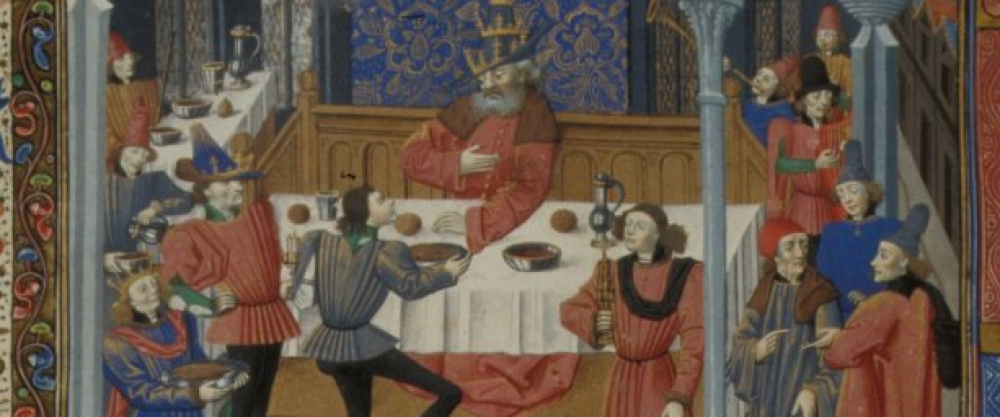What was the bread of the early English like? Our research hasn’t yet reached the point where we can give the last word about the bread of the Anglo-Saxons, but the basic facts are fairly clear. It’s predictable that early English bread differed in innumerable ways from the fluffy loaves of sliced white bread you find in plastic wrappers in the supermarket. What’s perhaps more surprising is that it was also quite different from the modern “artisan loaf” you find in the local bakery. Here are five main ways in which early English bread differed from modern bread, and a few topics for another day. 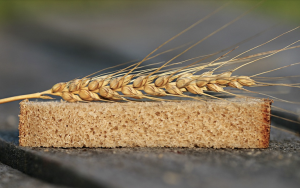
Ingredients. Only the bread of the elite would have seemed familiar to modern eaters, and that means the bread of a tiny percentage of the population. This elite bread was made of wheat, or largely of wheat. The taste and superior rise of wheat loaves put wheat at the top of the bread hierarchy, even though bread wheat was the hardest grain to grow in the English climate. And at the top of the wheat hierarchy were white loaves, the most highly processed, most expensive, most coveted, and rarest loaves. To most Anglo-Saxons, these were no more standard fare than modern wedding cake is standard modern supper fare.
Regular loaves were neither white nor all-wheat. Even those who were wealthy enough to afford wheat in their bread probably often mixed the wheat flour with other cereals and ingredients: rye, barley, and oats.* The bread of the poor, i.e. of most people, might be some combination of rye, barley, oats, and pulses — peas and beans. The only actual bread that has survived from Anglo-Saxon England is mixed wheat and rye. (More on this actual surviving bread in a later post.) As you went down the social scale, the bread would increasingly be made of these non-wheat options, so that most people probably ate more of these than bread wheat. Even for those who ate wheat, it might not be bread wheat like our modern wheat; they also cultivated more ancient variants, such as emmer and spelt. (Spelt, incidentally, is very yummy, not to mention that it doesn’t provoke digestive problems for people with Irritable Bowel or on the FODMAPs diet.)
It almost goes without saying that early medieval bakers used local grains, rather than cereal that had been grown at a distance, or halfway across the world.
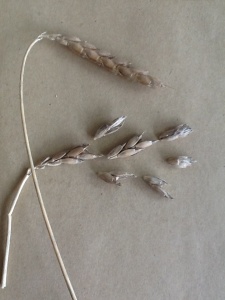
Spelt
Their bread consisted of these grains and possibly pulses, water, leavening, and sometimes salt. None of the other stuff that goes into modern bread, particularly American bread, which is notoriously sweet. For instance, this recipe for “Multigrain Bread” from Martha Stewart not only contains grains (whole wheat and white flour, bulgar, rye, oats, flaxseeds, and sunflower seeds), but also butter, honey, and egg whites. All of that is fancy modern frippery; the Anglo-Saxons never could have imagined such a thing.
Grinding. The biggest difference here is that bread was made with ultra-fresh flour, flour that had been ground very recently, often, as in more modern hand-grinding cultures, that same day. This reportedly gives the bread a remarkable sweetness. Modern commercial flour is aged at least six weeks and is often years old by the time you use it. There is also the issue of what remains after the grinding. Cereal grains are made up of three parts: the germ (the embryo, the part that sprouts), the endosperm (the rest of the inside, equivalent to the white of an egg), and the bran (the tough outside). Modern flour often has the germ removed, since that part spoils fastest. But because early English flour was used so soon after grinding, the germ could be left in. Modern flour is often “enriched” to replace the nutrients removed by processing, but early medieval flour would have retained the majority of those nutrients. Plus added protein from weevils!

This flour, hand-ground with a quern by our valiant researcher, has particles of various sizes. You’d have to have the patience to put it through the quern a second time if you wanted finer flour.
All early medieval flour was stone-ground, either by hand-grinding with querns (stone hand-mills), or by water-mills. The differences between stone-ground flour and flour ground by modern roller milling would take up several posts on this subject alone, but suffice it to say for right now that there will be differences. Modern home-ground flour is usually ground with electric or hand grinders rather than with a quern, which produces a very fine flour, reportedly at higher temperatures — does anyone have experience with this they want to report on?
Leavening. As now, the early English had two ways of leavening bread: with yeast (in their case, left over from the ale-brewing process), or with sourdough starter. Ale-brewing produced barm, or a layer of yeast, Saccharomyces cerevisiae, which was used to leaven dough. Sourdough starter uses a culture of flour, water, and wild yeast that has been floating around the air or living on the flour; modern sourdough yeast is Saccharomyces exiguus or one or more of nineteen other varieties.**
Baking. Ovens were for the wealthy, powerful, and organized, such as monasteries. They took a lot of resources to build and to heat, and even in the later Middle Ages a whole village might share a single oven. When the baker prepared to bake, the fire was built inside first to heat the oven, and then swept out before the bread went in. This means that the bread was not baked over an active fire, but in a temperature that dropped throughout the baking.
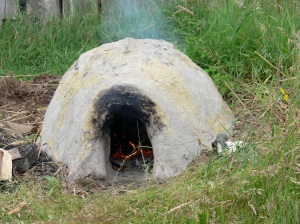
Re-creation of an Anglo-Saxon oven at West Stow
Individual villagers seem to have cooked their bread two other ways. They might put the loaf on a bakestone — a thin, flat stone over the fire — and invert a pot over the top. They might pile fuel around it for extra heat. Or they might just put the bread on the stone or on an iron griddle and cook it that way. This would have been particularly tempting for bread that wasn’t going to rise that much anyway, such as oatcakes, or any non-wheat bread. There’s also a possibility that they buried loaves in the hearth to bake, as other cultures have done.
What this means is that bread baked as we think of it, in a large, purpose-built oven, was probably a specialty item in early England. Most bread was probably “cooked” rather than baked as we think of it.
Fluffiness. Nowadays the epitome of good bread is lightness and fluffiness. In early England these were the characteristics of the bread of the rich, and it is no coincidence that white, wheaten bread baked in a purpose-built oven — the bread of the rich — is the kind that rises the highest. As William Rubel has pointed out in his fascinating book Bread: A Global History, this is the kind of loaf that serves as a silent brag for its owner: “I don’t have to live solely on bread.” Most bread was dark, dense, and almost meaty. A few hearty slices of that bread, maybe topped with butter or cheese if you could afford it, and you felt as though you’d had a meal.
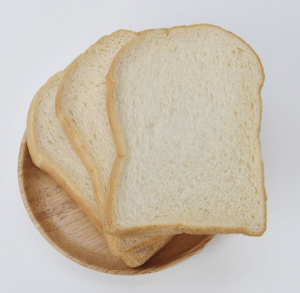
Not Anglo-Saxon bread, not in any way.
To sum up, the average loaf was made of mixed grains, perhaps with pulses as well, and without the additives of much modern bread; the flour was ground not long before baking; the loaf was leavened with barm from brewing or from sourdough starter, and probably didn’t rise much, so that it made a moist, dense loaf; and it was baked on a hearth rather than in an oven. And it formed most of what any Anglo-Saxon ate all day.
Shape, Magic, Meaning. The shape of the loaves, the magic and charms involved in their making, and the meaning of it all — large topics for another day!
We welcome thoughts and experiences from those who have experimented with these variables!
— MB
* And another grain, recently discovered, which we will cover once the news is publicly available.
** For a list of the numerous yeasts found in modern sourdough, check the list in Bread and its Fortification: Nutrition and Health Benefits, ed. C. M. Rosell et al. (Boca Raton: CRC Press, 2015), pp. 54-55, which you can get at via Google Books.
